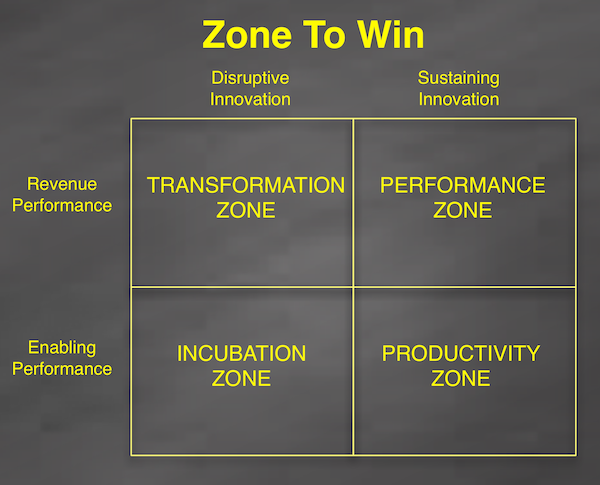Last summer over lunch with the CTO & co-founder of Care.com, Dave Krupinski, we got to talked about the challenge of managing new products innovation inside an existing growing business. Dave, a former colleague from Easel days, had done what every entrepreneur dreams of doing: building his idea into a successful, growing and long lasting public company. While I was still a long way from a public company, my business was in a high growth phase that made the topic particularly relevant to me. As we discussed our respective innovation challenges, Dave suggested I read a book called Zone To Win by Geoffrey Moore.

While you'd have to be living under a tech industry rock to not know Geoffrey Moore, I'll confess to never having heard of Zone To Win. Sure I read his 1991 best seller Crossing the Chasm and its obligatory follow up Inside the Tornado. But not long after our lunch, I found myself back in the chaos of a fast-moving startup and months went by before Dave's recommendation suddenly became relevant to my world.
While I'm not a big reader of business self-help, I was fascinated by the simple but powerful model revealed by Moore. He introduces the concept of four zones that an enterprise must manage:
- Performance Zone - The core products that drive your business and comprise most of your top line revenue.
- Productivity Zone - The shared service investments and programs that serve to optimize your core business (a.k.a. the Performance Zone).
- Incubation Zone - New offers and products in emerging and/or fast growing markets that do not yet deliver a material amount of revenue, but some day could be relevant to your business.
- Transformation Zone - A new product or offer in an emerging and/or fast rowing market that is actively being driven to have a material impact on the business (at least 10% of revenues).
Moore asserts that to manage a healthy enterprise business, it is necessary to isolate and execute strategies across each of these four zones. The Performance Zone keeps the organization focused on its primary goal: making its number. The Productivity Zone maintains efficiency and compliance to support the core business, delivering optimizations that enable investments in future lines of business. The Incubation Zone is the enterprise science lab, where new ideas are hatched that could some day transform the business. And finally, the Transformation Zone allows for an organization to manage the transformation of its business by investing in one (and only one) product line to graduate it into the Performance Zone.
Each zone needs to be managed differently, with its own leadership, goals and constraints. Trying to manage an emerging product in the Transformation Zone with the same approach as the Performance Zone will lead to failure. Equally important is to not try to subject your organization to frequent and unnecessary transformations, which will serve to take away your focus on the Performance and Productivity Zones required for business success.
While the book is specifically written for an enterprise business leader, it's core concepts can be easily applied to a high growth startup. It not only discusses how to arrange the portfolio, but also delves into how to manage the zones when your business is booming or under disruption. I'm giving Zone To Win a +1 and recommend you give it a read.
